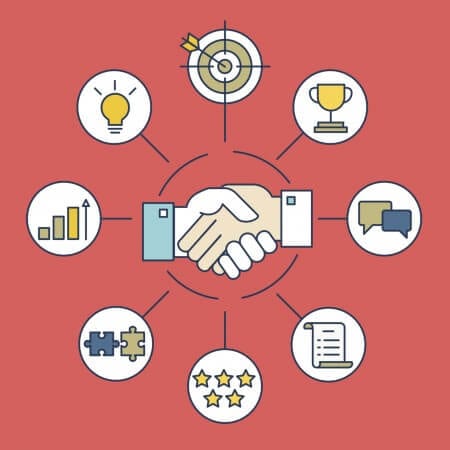One of the largest opportunities to improve business performance today is to align your marketing and sales teams. In this blog we will explain how to help your company add value and generate more revenue by integrating smarketing into your organization.
What is Smarketing?
Smarketing is a modern take on aligning your sales and marketing teams. By encouraging both teams to have constant communication, they are able to help each other reach their goals. HubSpot reported that 87 percent of the terms sales and marketing teams use to describe each other are negative. It is apparent that many sales and marketing departments view each other as two separate entities. When it comes to practicing inbound marketing, it is time to break the barriers and find a way for the sales and marketing teams to collaborate.
How to Align Your Sales and Marketing Teams
Defined Goals
Marketing and sales differ in many ways when it comes to creating their business goals. Marketing goals tend to be long-term, such as focusing on increasing brand awareness. Meanwhile, salespeople are geared to meet their monthly or quarterly quotas, so they focus on short-term goals. By taking the time to understand each other’s goals and progress, they will be able to help generate more revenue for the company as a whole.
Defined Buyer Personas
Defining your buyer personas is vital for marketing success. It is important that your sales and marketing teams have a clear understanding of the buyer personas that your company is targeting, so they know who to market to and who to sell to.
Integrating Smarketing into Your Company
Once your sales and marketing teams align their business goals and buyer personas, they can begin integrating smarketing into the company by following these steps.
Define Your Funnel
In order to unify your marketing and sales teams, there needs to be mutually agreed upon definitions of each stage of the sales and marketing funnel. The funnel is divided into three sections, with marketing responsible for the top of the funnel, sales responsible for the bottom and a shared responsibility for the middle. Within each section of the funnel, each lifecycle stage needs to be defined so that both teams are always on the same page
Lead Quality
Once the funnel has been defined and agreed upon between the marketing and sales teams, they can begin. As leads are generated, they should be ranked according to type of lead, capability and level of interest. This will help navigate the hand-off point between marketing and sales teams.
- Marketing Qualified Leads (MQL): contacts who have shown a high level of interest in your company and can be passed on to the sales team.
- Sales Qualified Leads (SQL): leads that the marketing team has defined as great fits for your company.
Closed Loop Reporting
Closed loop reporting is when the marketing team provides the sales team with lead data and in return, the sales team provides feedback to the marketing team. This helps to understand which marketing efforts are working best throughout each stage of the funnel and how many leads are being converted into customers.
Service Level Agreements
A Service level Agreement (SLA) defines what each team commits to accomplishing in order to support the other. This refers to the original goals that were set by each team and how they can help each other to achieve their goals. A marketing to sales SLA is based on how many quality leads a salesperson needs to make their quota. A sales to marketing SLA is based on how many follow-up attempts a salesperson needs to make per lead.

Regular Communication
Finally, to make sure that both teams are on the same page at all times, there needs to be weekly smarketing meetings and monthly management meetings. Also, the marketing team should update the sales team about campaigns and updated products or services. The sales team needs to be in the loop in order to successfully sell to qualified leads.




